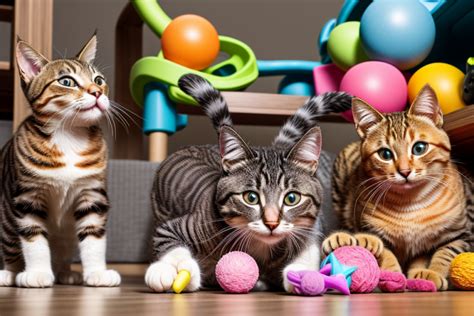Understanding Your Cat’s Playtime Needs
Cats are natural predators with a strong hunting instinct. Playtime provides an outlet for this instinct, helps them stay active and healthy, and strengthens their bond with their owners. According to the American Veterinary Medical Association (AVMA), cats should engage in at least 30 minutes of playtime each day, divided into several shorter sessions.

Types of Cat Toys
There are countless cat toys available, each designed to cater to a specific play style and preference. Here are some popular toy categories:
| Type of Toy | Benefits |
|---|---|
| Interactive toys: These toys allow cats to chase, pounce, and capture objects, stimulating their hunting instincts. Examples include laser pointers, wand toys, and electronic toys. | Foster mental and physical stimulation, helping cats stay entertained and active. |
| Puzzle toys: These toys require cats to solve puzzles or challenges to access treats or rewards. Examples include treat-dispensing balls, food puzzles, and activity boards. | Improve problem-solving skills, reduce boredom, and provide a sense of accomplishment. |
| Crinkle toys: These toys make a crinkling sound when manipulated, which cats find irresistible. They come in various shapes and sizes, including mice, fish, and birds. | Appeal to cats’ natural curiosity and hunting instincts, providing interactive playtime. |
| Catnip toys: Catnip toys are infused with catnip, a plant that has an intoxicating effect on cats, making them playful and energetic. They can be used for short bursts of high-energy playtime. | Stimulate cats’ playful behavior, providing a fun and engaging experience. |
| Scratching posts and boards: These toys allow cats to scratch, which is a natural behavior that helps maintain their claws and mark their territory. They are available in various materials, including cardboard, sisal, and carpet. | Provide an outlet for cats’ scratching behavior, preventing damage to furniture and carpets. |
Choosing the Right Toys for Your Cat
When selecting toys for your cat, consider their age, activity level, and individual preferences. Here are some tips:
- Kittens: Kittens are highly energetic and playful. Choose interactive toys that encourage chasing and pouncing, such as wand toys or laser pointers.
- Adult cats: Adult cats may prefer toys that stimulate their curiosity or challenge their intelligence, such as puzzle toys or activity boards.
- Senior cats: Senior cats may have reduced mobility and energy levels. Choose toys that are easy to play with, such as crinkle toys or scratching posts.
The Importance of Playtime for Cats
Playtime is essential for cats’ physical, mental, and emotional well-being. Here are some of its benefits:
- Physical exercise: Playtime provides cats with the opportunity to run, jump, and climb, helping them stay active and fit. This is particularly important for indoor cats who do not have access to the outdoors.
- Mental stimulation: Toys that challenge cats’ minds, such as puzzle toys and activity boards, help reduce boredom and prevent cognitive decline.
- Bonding with owners: Playtime is a great way to bond with your cat. It provides an opportunity to interact with them, show them affection, and build a strong relationship.
- Stress relief: Playtime can help reduce stress and anxiety in cats. It provides them with an outlet for their energy and allows them to release pent-up emotions.
How to Make Playtime More Engaging
To make playtime more enjoyable and stimulating for your cat, follow these tips:
- Variety is key: Offer your cat a variety of toys to keep them engaged and prevent boredom.
- Create a safe play space: Ensure that your cat’s play area is free from hazards and large enough for them to run and jump around.
- Play regularly: Schedule regular playtime sessions, even if they are short, and stick to them as much as possible.
- Participate in playtime: Play with your cat yourself by using interactive toys or chasing them around. This helps strengthen your bond and provides them with mental stimulation.
Common Mistakes to Avoid
Avoid these common mistakes when playing with your cat:
- Over-stimulation: Avoid playing with your cat for too long, as this can lead to over-stimulation and exhaustion.
- Rough play: Do not engage in rough play with your cat, as this can lead to aggression or injuries.
- Ignoring your cat: Do not ignore your cat’s playtime cues. Pay attention to their body language and respond accordingly.
- Using toys that are too small or dangerous: Choose toys that are appropriate for your cat’s size and chewing habits. Avoid toys that are small enough to be swallowed or have sharp edges.
Future Trends and Innovations in Cat Toys
The cat toy industry is constantly evolving, with new innovations emerging regularly. Here are some future trends to watch for:
- Interactive toys with artificial intelligence: Toys that use artificial intelligence (AI) to learn your cat’s play preferences and adapt their behavior accordingly.
- Toys that promote multi-sensory stimulation: Toys that engage multiple senses, such as sight, sound, and touch, to provide a more immersive playtime experience.
- Toys that connect to the internet: Toys that allow you to monitor your cat’s playtime activity and interact with them remotely.
Conclusion
Playtime is an essential aspect of a cat’s life, providing them with physical, mental, and emotional benefits. By understanding your cat’s play style and preferences, choosing the right toys, and making playtime a regular part of their routine, you can help ensure that your feline friend is happy, healthy, and well-adjusted. As the cat toy industry continues to innovate, we can expect to see even more engaging and exciting ways to keep our beloved cats entertained for years to come.





















